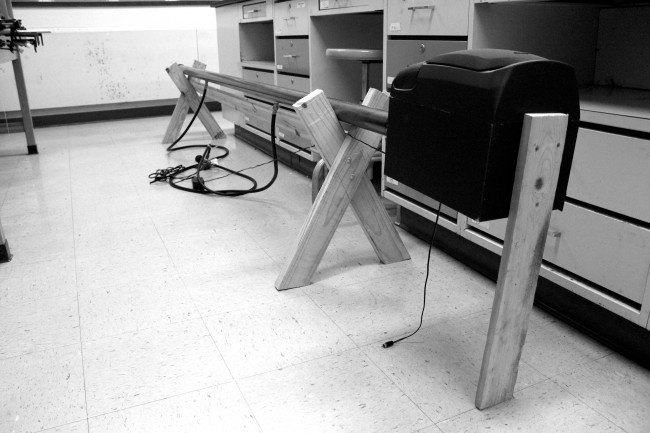

Photo Credit / Jamie Reese
By Christopher Cocuzza and Nicholas Lukow
SC Staff Writers
Within the halls of Gessner lies a black tube, riddled with holes and connected to a gas port and a speaker.
This device is called a “Rubens’ Tube” or a “standing wave flame tube.” German physicist Heinrich Rubens invented the Rubens’ Tube in 1905 to demonstrate the pressure created by sound waves.
Nowadays, it is often used as a demonstrative tool to generate interest in the physical sciences.
Such was the goal of ESU’s Society of Physics Students or SPS, when they began work on the Rubens’ Tube last year. Several physics students dedicated their time to understanding and building the device.
At the center of the device lies a black metal tube with evenly spaced holes.
On one end of the tube is a speaker box with multiple speakers. One speaker channels its sound waves into the tube while another faces outward. The second speaker allows observers to hear the music or tone being played.
A propane tank is connected to the tube as well. This allows for gas to escape from the holes.
When tuned to specific frequencies, the speaker will generate a standing wave within the tube.
An arbitrary wave will cause the pressure inside the tube to change constantly. A standing wave is unique because it will create points in the tube where the pressure is constant.
At these special points, called nodes, more gas will escape from the tube. This is due to a phenomenon known as Bernoulli’s principle, which states that fluids flow faster at lower pressures.
Because the pressure varies at different points along the tube, different amounts of gas will escape, creating a wave phenomenon.
Set the gas ablaze, and the waves can be seen in the fluctuating heights of the flames.
When music is played through the tube, the nodes move. The result is a dance of fire, as columns of flame seem to move, shrink, and grow with the music. This spectacle is responsible for the Rubens’ Tube’s popularity as a physics demonstration.
The Society of Physics Students finished their work on the Rubens’ Tube early this year. Since then, it has been displayed at club events, such as the Warrior Welcome Festival.
The club hopes to find more opportunities in the future to present the Rubens’ Tube and is currently planning another build to generate interest in physics at ESU.
One idea for the build is a Rubens’ Plate, a two-dimensional version of the Rubens’ Tube consisting of a square plate riddled with holes.
Email Christopher at:
ccocuzza@live.esu.edu
Email Nicholas at:
nlukow@live.esu.edu
